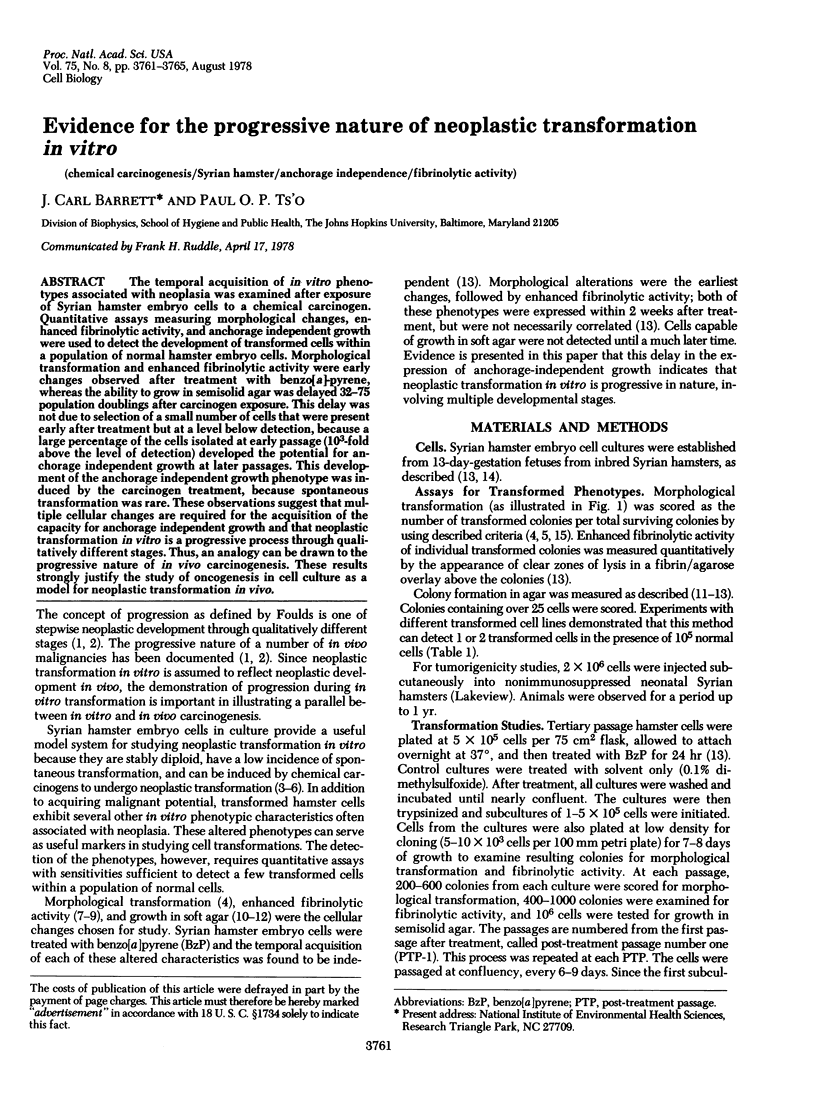Evidence for the progressive nature of neoplastic transformation in vitro (original) (raw)
Abstract
The temporal acquisition of in vitro phenotypes associated with neoplasia were examined after exposure of Syrian hamster embryo cells to a chemical carcinogen. Quantitative assays measuring morphological changes, enhanced fibrinolytic activity, and anchorage independent growth were used to detect the development of transformed cells within a population of normal hamster embryo cells. Morphological transformation and enhanced fibrinolytic activity were early changes observed after treatment with benzo[alpha]-pyrene, whereas the ability to grow in semisolid agar was delayed 32-75 population doublings after carcinogen exposure. This delay was not due to selection of a small number of cells that were present early after treatment but at a level below detection, because a large percentage of the cells isolated at early passage (10(3)-fold above the level of detection) developed the potential for anchorage independent growth at later passages. This development of the anchorage independent growth phenotype was induced by the carcinogen treatment, because spontaneous transformation was rare. These observation suggest that multiple cellular changes are required for the acquisition of the capacity for anchorage independent growth and that neoplastic transformation in vitro is a progressive process through qualitatively different stages. Thus, an analogy can be drawn to the progressive nature of in vivo carcinogenesis. These results strongly justify the study of oncogenesis in cell culture as a model for neoplastic transformation in vivo.

Images in this article
Selected References
These references are in PubMed. This may not be the complete list of references from this article.
- BERWALD Y., SACHS L. IN VITRO CELL TRANSFORMATION WITH CHEMICAL CARCINOGENS. Nature. 1963 Dec 21;200:1182–1184. doi: 10.1038/2001182a0. [DOI] [PubMed] [Google Scholar]
- Barrett J. C., Bias N. E., Ts'o P. O. A mammalian cellular system for the concomitant study of neoplastic transformation and somatic mutation. Mutat Res. 1978 Apr;50(1):121–136. doi: 10.1016/0027-5107(78)90067-2. [DOI] [PubMed] [Google Scholar]
- Barrett J. C., Crawford B. D., Grady D. L., Hester L. D., Jones P. A., Benedict W. F., Ts'o P. O. Temporal acquistion of enhanced fibrinolytic activity by syrian hamster embryo cells following treatment with benzo(a)pyrene. Cancer Res. 1977 Oct;37(10):3815–3823. [PubMed] [Google Scholar]
- Barrett J. C., Crawford B. D., Ts'o P. O. Quantitation of fibrinolytic activity of Syrian hamster fibroblasts using 3H-labeled fibrinogen prepared by reductive alkylation. Cancer Res. 1977 Apr;37(4):1182–1185. [PubMed] [Google Scholar]
- Berwald Y., Sachs L. In vitro transformation of normal cells to tumor cells by carcinogenic hydrocarbons. J Natl Cancer Inst. 1965 Oct;35(4):641–661. [PubMed] [Google Scholar]
- Carver J. H., Dewey W. C., Hopwood L. E. X-ray-induced mutants resistant to 8-azaguanine. I. Effects of cell density and expression time. Mutat Res. 1976 Mar;34(3):447–463. doi: 10.1016/0027-5107(76)90222-0. [DOI] [PubMed] [Google Scholar]
- DiPaolo J. A., Donovan P., Nelson R. Quantitative studies of in vitro transformation by chemical carcinogens. J Natl Cancer Inst. 1969 May;42(5):867–874. [PubMed] [Google Scholar]
- Dipaolo J. A., Donovan P. J. Properties of Syrian hamster cells transformed in the presence of carcinogenic hydrocarbons. Exp Cell Res. 1967 Nov;48(2):361–377. doi: 10.1016/0014-4827(67)90361-8. [DOI] [PubMed] [Google Scholar]
- Freedman V. H., Shin S. I. Cellular tumorigenicity in nude mice: correlation with cell growth in semi-solid medium. Cell. 1974 Dec;3(4):355–359. doi: 10.1016/0092-8674(74)90050-6. [DOI] [PubMed] [Google Scholar]
- Jones P., Benedict W., Strickland S., Reich E. Fibrin overlay methods for the detection of single transformed cells and colonies of transformed cells. Cell. 1975 Jul;5(3):323–329. doi: 10.1016/0092-8674(75)90108-7. [DOI] [PubMed] [Google Scholar]
- Kakunaga T., Kamahora J. Properties of hamster embryonic cells transformed by 4-nitroquinoline-1-oxide in vitro and their correlations with the malignant properties of the cells. Biken J. 1968 Dec;11(4):313–332. [PubMed] [Google Scholar]
- Kuroki T., Sato H. Transformation and neoplastic development in vitro of hamster embryonic cells by 4-nitroquinoline-1-oxide and its derivatives. J Natl Cancer Inst. 1968 Jul;41(1):53–71. [PubMed] [Google Scholar]
- Laerum O. D., Rajewsky M. F. Neoplastic transformation of fetal rat brain cells in culture after exposure to ethylnitrosourea in vivo. J Natl Cancer Inst. 1975 Nov;55(5):1177–1187. doi: 10.1093/jnci/55.5.1177. [DOI] [PubMed] [Google Scholar]
- MACPHERSON I., MONTAGNIER L. AGAR SUSPENSION CULTURE FOR THE SELECTIVE ASSAY OF CELLS TRANSFORMED BY POLYOMA VIRUS. Virology. 1964 Jun;23:291–294. doi: 10.1016/0042-6822(64)90301-0. [DOI] [PubMed] [Google Scholar]
- Mondal S., Brankow D. W., Heidelberger C. Two-stage chemical oncogenesis in cultures of C3H/10T1/2 cells. Cancer Res. 1976 Jul;36(7 Pt 1):2254–2260. [PubMed] [Google Scholar]
- Ossowski L., Unkeless J. C., Tobia A., Quigley J. P., Rifkin D. B., Reich E. An enzymatic function associated with transformation of fibroblasts by oncogenic viruses. II. Mammalian fibroblast cultures transformed by DNA and RNA tumor viruses. J Exp Med. 1973 Jan 1;137(1):112–126. doi: 10.1084/jem.137.1.112. [DOI] [PMC free article] [PubMed] [Google Scholar]
- Penman B. W., Thilly W. G. Concentration-dependent mutation of diploid human lymphoblasts by methylnitronitrosoguanidine: the importance of phenotypic lag. Somatic Cell Genet. 1976 Jul;2(4):325–330. doi: 10.1007/BF01538837. [DOI] [PubMed] [Google Scholar]
- Pollack R., Risser R., Conlon S., Rifkin D. Plasminogen activator production accompanies loss of anchorage regulation in transformation of primary rat embryo cells by simian virus 40. Proc Natl Acad Sci U S A. 1974 Dec;71(12):4792–4796. doi: 10.1073/pnas.71.12.4792. [DOI] [PMC free article] [PubMed] [Google Scholar]
- Van Zeeland A. A., Simons J. W. Linear dose--response relationships after prolonged expression times in V-79 Chinese hamster cells. Mutat Res. 1976 Apr;35(1):129–137. doi: 10.1016/0027-5107(76)90175-5. [DOI] [PubMed] [Google Scholar]